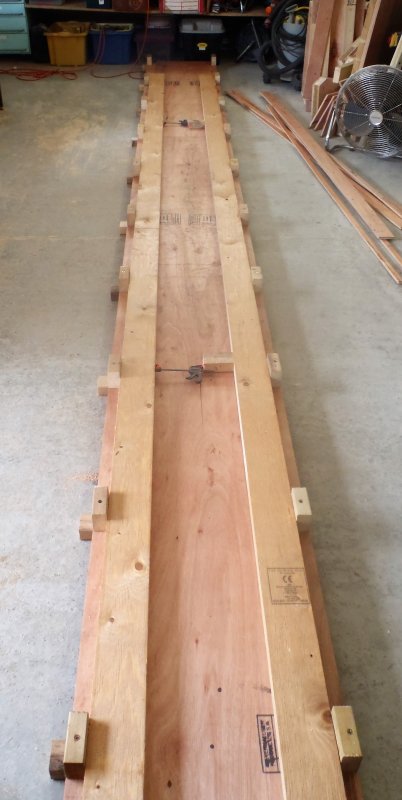Today, we set out to build the enormous template that will hold all the pieces that makes up a rafter element. The longest rafter we have to manufacture is 6.1metres long! So we took 2 sheet of our regular 12mm thick plywood and cut 3 strips of each being 476mm wide. Then we chopped up 12 CLS timber pieces each measuring 590mm long to provide the footings under the plywood and also joiners to connect the 3 strips together. Then, we again chopped up some further 26 pieces of CLS timber but this time being 100mm long. These had a 6mm hole drilled down through the wider direction and with a 100mm long screws, were fixed down on the edges of the plywood at the same position of the footings. These smaller items provides constraint to brace and hold the flanges in place when we assemble the each rafter in turn.
There was a special requirement to cater for, for the LVL diagonal rafters and ridge beams, where all 17 of this type, comes in a variety of sizes, but most importantly, about 5 different heights. This means that we had to have some means of extending the width of the template and we did this by cutting a further 9 strips of the plywood, a set of 23mm wide, a set of 33mm and finally a set of 76mm wide strips which we can place alongside the main plywood base board and extend the overall width by a combination of different width by using one or two strips together and screw the second constraints in place to lock the whole lot tight.
It only just fitted on the floor of our workshop, the total length of our template is 6.6metres long! Phew!
We stopped slightly early to go back to the computer to make a definite and final list of the LVL rafters and ridges along with their sizes and how many plywood webbing strips we would need to build each rafter.
Tomorrow, we will slice up some more plywood sheets to make a stock pile of prepared webbing and also the same for the polystyrene foam strips too.

